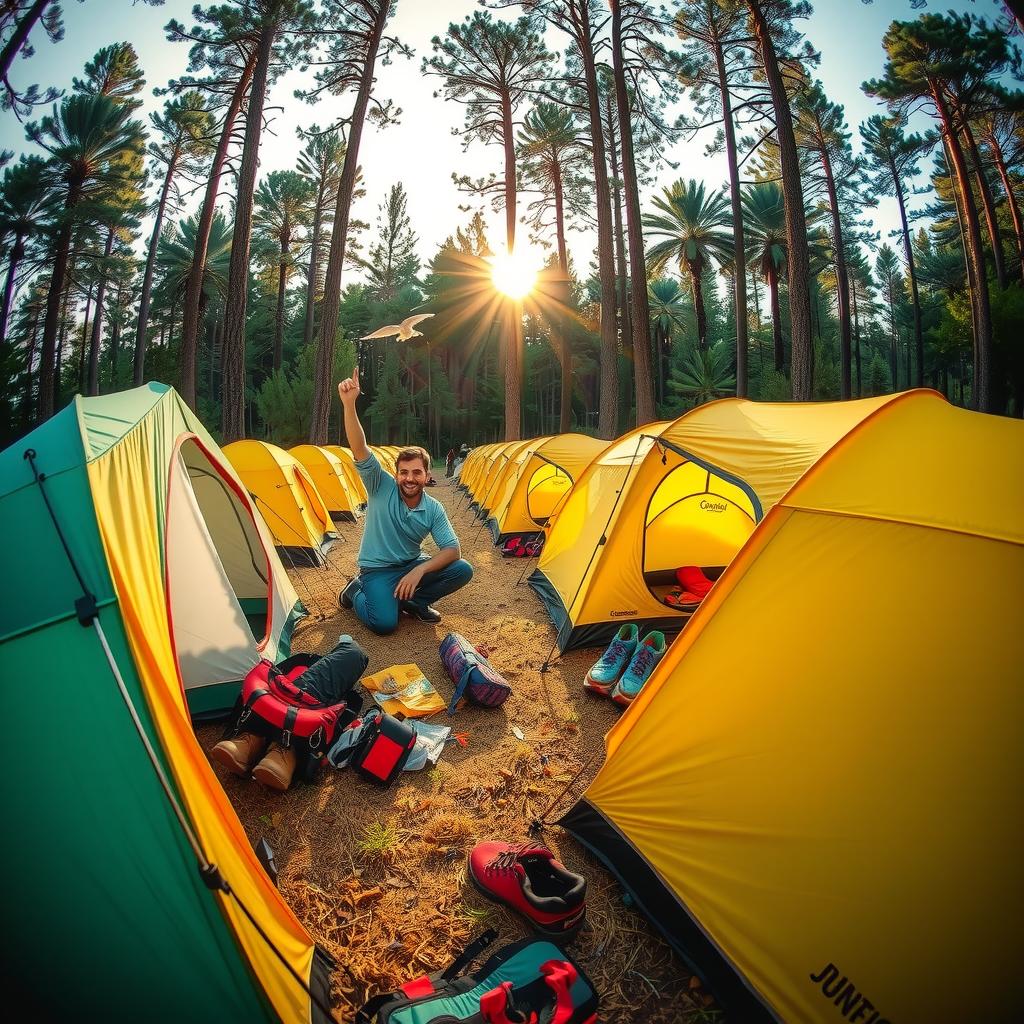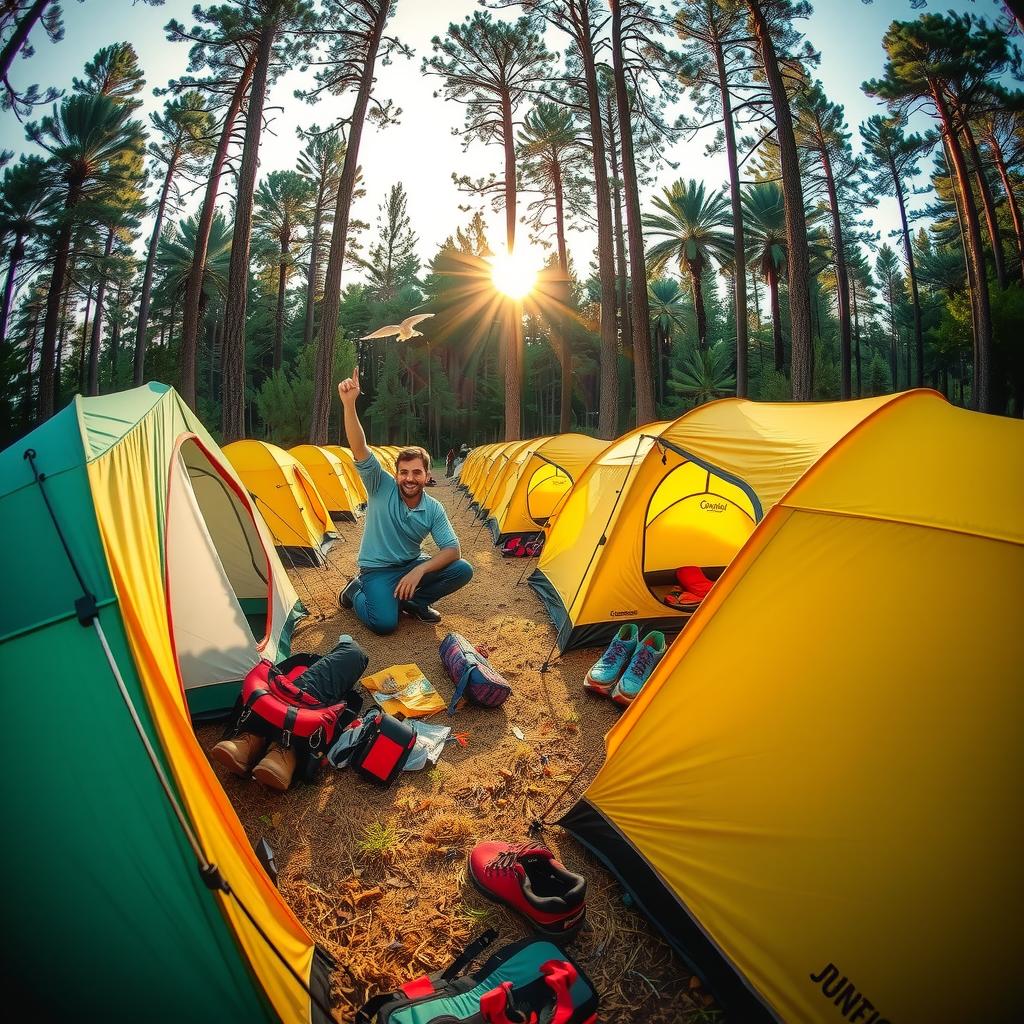Setting off on a camping adventure can be both thrilling and daunting for beginners, especially when it comes to the crucial task of tent pitching. Picture this: after an exhilarating hike or a long drive, one of the first challenges faced is getting that tent up quickly and efficiently before night falls. Unfortunately, many newcomers often find themselves tangled in confusing instructions or wrestling with stubborn poles, leading to frustration instead of relaxation. This blog post aims to demystify the art of tent installation, providing essential tips that will empower novices with important outdoor skills necessary for a successful camping experience.
Understanding how to pitch a tent properly not only enhances comfort but also ensures safety during your outdoor escapades. The core value of mastering these camping basics lies in transforming what could be an overwhelming experience into an enjoyable one—allowing campers to focus more on exploring nature rather than grappling with gear. In this guide, readers will discover practical techniques tailored specifically for beginners while addressing common pitfalls encountered along the way.
From selecting the right location free from hazards like rocks and roots to understanding how weather conditions impact your setup choices, each section offers insights designed to build confidence among new campers. Moreover, employing effective camping techniques such as using stakes correctly or ensuring proper tension across guylines can make all the difference between a restful night under stars and an uncomfortable evening battling against flapping fabric.
As we dive deeper into these valuable pitching strategies throughout our article, readers are encouraged to embrace their inner explorer by equipping themselves with knowledge that transforms mere survival into true enjoyment while immersing themselves in nature’s splendor. So whether you’re planning your first family outing or gearing up for solo adventures in distant woods, let this comprehensive setup guide illuminate your path toward becoming adept at effectively pitching tents like a pro!

Key Points:
-
Choosing the Right Campsite: Understanding terrain is crucial for successful tent pitching. Beginners should look for flat, dry ground free from rocks and debris. This foundational step sets the stage for a comfortable night’s sleep and aids in effective tent installation, ensuring stability against wind and rain.
-
Mastering Tent Setup Techniques: Familiarizing oneself with basic camping techniques can significantly ease the process of erecting a tent. Novices are encouraged to practice how to unfold and assemble their tents before heading out. This includes learning how to properly stake down a tent and secure guylines, which enhances safety during unpredictable weather conditions.
-
Navigating Common Challenges: Newcomers often face obstacles when setting up their camping shelter, such as uneven surfaces or inadequate knowledge about different types of tents. By addressing these common issues through practical solutions, beginners will cultivate essential outdoor skills. These insights not only facilitate smoother tent installation but also enrich overall camping experiences by fostering confidence in managing one’s environment effectively.

Choosing the Right Campsite
Assessing Terrain and Conditions for Your Tent Setup
When embarking on a camping adventure, selecting the right campsite is crucial to ensure an enjoyable experience. Beginners often overlook the importance of terrain evaluation in their tent pitching process. The first step involves scouting for level ground; uneven surfaces can lead to uncomfortable sleeping arrangements and may even compromise tent stability during inclement weather. It’s essential to check for rocks, roots, or any debris that could disrupt a smooth setup. Moreover, understanding local conditions plays a significant role; sites prone to flooding should be avoided when choosing where to install your tent. A good rule of thumb is to set up camp at least 200 feet away from bodies of water while considering wind direction, as this will help protect campers from harsh elements.
Another critical aspect of campsite selection pertains to natural shelter availability. Camping techniques dictate looking for trees or shrubs that can provide cover against rain and wind without being too close—falling branches pose risks during storms. For those using modern gear like waterproof tents with robust materials, it’s still wise not to underestimate nature’s unpredictability. Being aware of wildlife trails is also key; placing tents near such paths could inadvertently attract unwanted visitors at night.
To further enhance your outdoor skills, consider factors such as sunlight exposure throughout the day when planning your tent installation site. Morning sun can aid in drying dew off equipment but excessive afternoon heat might render afternoons unbearable unless shaded appropriately by trees or other structures nearby. Additionally, beginners’ tips suggest assessing proximity to amenities like fire pits and restrooms since these play pivotal roles in comfort levels during extended stays.
Ultimately, successful camping hinges on thoughtful preparation regarding terrain assessment and environmental awareness before setting up one’s abode under the stars—a true embodiment of camping basics every enthusiast should master over time through practice and observation.
Finding Your Perfect Spot
Elevating Your Camping Experience Through Strategic Site Selection
Strategically selecting where you pitch your tent enhances not only comfort but overall enjoyment while immersing oneself in nature’s beauty. Alongside evaluating flatness and safety concerns previously mentioned—like avoiding low-lying areas prone to moisture accumulation—it’s imperative that campers take into account soil quality as well when deciding on their location for optimal tent pitching experiences ahead! Sandy soils drain quickly while clay-like earth retains moisture longer which affects how comfortable one feels after rainfall occurs overnight!
Furthermore—the presence (or absence) thereof certain vegetation types serves various purposes: tall grasses may indicate damp conditions below yet flowering plants signify nutrient-rich grounds conducive towards attracting local fauna which adds vibrancy around campsites enhancing ambiance! Maintaining cleanliness within chosen locales remains important too—you wouldn’t want litter ruining tranquility experienced outdoors nor would you wish upon yourself potential encounters with pesky insects drawn toward food remnants left behind carelessly scattered about after meals are finished cooking over flames built safely nearby following proper guidelines established amongst seasoned enthusiasts alike who share insights related directly back towards effective implementation/follow-through concerning best practices surrounding vital setup guides ensuring smoother transitions between activities throughout entire trip duration.
In conclusion—it becomes evident that mastering basic principles associated with choosing ideal spots alongside understanding nuances involved therein ultimately leads participants closer toward achieving memorable adventures filled with laughter camaraderie all under starlit skies beckoning exploration beyond what lies just outside reach…
Essential Tent Setup Techniques
Mastering the Art of Pitching Your Tent
Setting up a tent can often appear daunting to beginners, yet mastering this essential outdoor skill is crucial for an enjoyable camping experience. Understanding the nuances of tent pitching transforms what may seem like a mere chore into a rewarding adventure. The first step in the setup guide involves selecting an appropriate campsite, which should ideally feature level ground free from debris and sharp objects. Once the site is chosen, it’s time to unpack your gear and lay out your tent. This process usually begins with identifying the tent’s front and back; most tents have distinct features that aid in recognizing their orientation, such as doors or ventilation windows. After laying it flat on the ground, ensure all components are accounted for: poles, stakes, guylines—each plays a pivotal role in securing your home away from home.
Securing Guylines for Stability
Once positioned correctly on firm terrain, attention turns to securing guylines—a critical aspect of effective tent installation that can greatly enhance stability against wind or inclement weather conditions. Guylines should be attached at specified points along the tent body before being extended outward at approximately 45-degree angles from each corner or side point where they are anchored to secure stakes driven deep into solid ground. When tying knots for these lines, techniques such as bowline knots are recommended due to their reliability under tension while still allowing easy adjustments when necessary. Furthermore, ensuring that guylines maintain tautness will minimize potential flapping during windy nights—a common cause of disturbances among campers aiming for restful sleep after long days spent outdoors.
Staking Down Effectively
The final phase of pitching tents revolves around staking down effectively—a straightforward yet vital part within any camping basics tutorial aimed at novices eager to refine their outdoor skills. Properly placed stakes not only stabilize but also protect against unexpected elements like rain or gusty winds by minimizing movement during storms. To stake down efficiently requires driving pegs vertically into soil rather than skewed angles; achieving this ensures maximum grip without risking dislodgment during high winds or wet conditions which could affect overall safety and comfort inside your shelter space later on through nightfall hours ahead! Additionally checking that all corners remain pulled tight afterward guarantees an optimal fit throughout use over several nights spent beneath stars—making every camper feel more secure in knowing their environment remains protected adequately against nature’s unpredictable whims while enjoying picturesque views unencumbered by discomfort stemming from improper setups initially overlooked prior beginning adventures together outside!
Common Challenges in Tent Pitching
Navigating the Hurdles of Outdoor Setup for New Campers
Setting up a tent can be an exhilarating yet daunting task for beginners venturing into the world of camping. One common challenge faced during this process is selecting the right location. Many novice campers may overlook critical factors like ground stability and proximity to water sources, which can significantly impact their experience. To tackle this issue effectively, it’s crucial to scout the area beforehand and choose a flat, dry space free from rocks or debris that could damage the tent floor or compromise comfort during sleep. Establishing a solid foundation not only enhances overall outdoor skills but also ensures easier tent installation, leading to more enjoyable nights under the stars.
Another frequent hurdle is understanding how to properly utilize all components of the tent setup. Beginners often find themselves confused by various poles, stakes, and rainflies included with their tents. To overcome this obstacle, one practical solution is referencing a comprehensive setup guide provided by manufacturers or reliable outdoor resources before heading out on an adventure. By familiarizing oneself with these elements in advance—perhaps even practicing at home—newcomers will feel more confident in their pitching techniques when it comes time to set up camp. Moreover, engaging with experienced campers through forums or community groups can provide valuable insights into effective pitching methods that have worked well for others.
Weather conditions pose another significant challenge while pitching tents outdoors; unexpected rain showers or gusty winds can quickly turn an exciting camping trip into a frustrating ordeal if not adequately prepared for them. A proactive approach involves bringing along essential gear such as waterproof tarps and sturdy guylines designed specifically for adverse weather conditions—a must-have for any serious camper’s inventory of camping basics! Additionally, learning how to secure your tent against wind by orienting it correctly relative to prevailing breezes will enhance its stability throughout your stay.
Lastly, many beginners struggle with correctly staking down their tents—a step that should never be underestimated in maintaining structural integrity once pitched. Inadequately secured corners often lead to sagging fabric and ultimately discomfort within while sleeping overnight outdoors due primarily because of shifting ground beneath them over time (especially if packing light). Thus employing proper techniques like placing stakes at angles away from the tent body guarantees maximum tension without risking future wear-and-tear issues on seams over lengthy trips.
Navigating these challenges requires patience and practice; however, armed with actionable tips rooted deeply within practical solutions tailored specifically towards newcomers interested in mastering essential tent-pitching skills—the path ahead becomes significantly clearer! Incorporating these strategies will undoubtedly empower new adventurers as they embark upon unforgettable journeys surrounded by nature’s beauty—all beginning under precisely pitched shelters crafted through determination combined alongside newfound knowledge gained along every step taken forward together toward success amidst beautiful landscapes waiting just outside our front doors!
Frequently Asked Questions:
Q: What is the best type of ground for tent pitching?
A: When selecting a campsite, look for level ground free from rocks and sharp objects. Soft soil or grass provides better support and comfort compared to hard or uneven surfaces, which can affect your overall camping experience.
Q: How do I ensure my tent stays secure during windy conditions?
A: To keep your tent stable in winds, it’s essential to stake down the corners firmly. Using additional guylines can provide extra support. Make sure that all stakes are angled away from the tent at about 45 degrees for maximum hold.
Q: Can beginners really set up a tent on their own with no prior experience?
A: Absolutely! With proper setup guides and by following step-by-step instructions, even those new to camping can successfully pitch tents. Familiarizing oneself with the components of the tent beforehand makes the process smoother and builds confidence in their outdoor skills.

